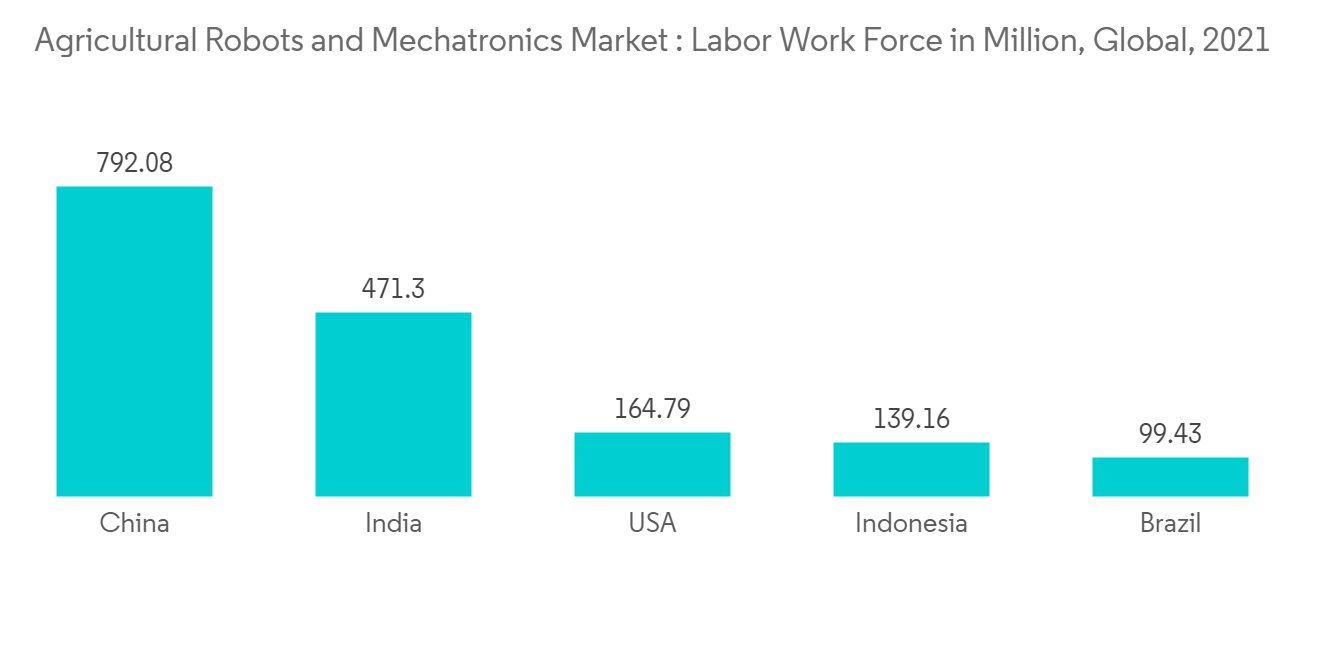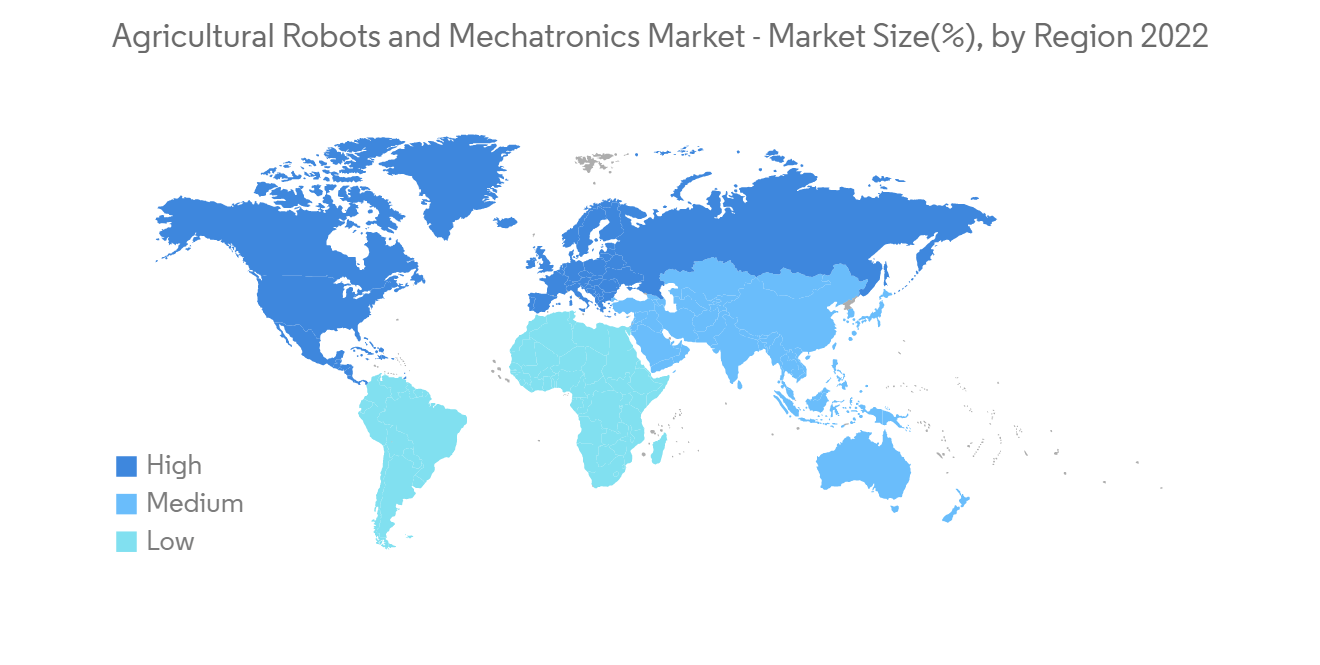PUBLISHER: Mordor Intelligence | PRODUCT CODE: 1272673

PUBLISHER: Mordor Intelligence | PRODUCT CODE: 1272673
Agricultural Robots and Mechatronics Market - Growth, Trends, and Forecasts (2023 - 2028)
The global agricultural robots and mechatronics market are anticipated to grow at a CAGR of 20.4% during the forecast period.
Key Highlights
- Robotics will bring the agricultural revolution. However, it would be interesting to see how the farmers, agri-businessmen, and consumers will utilize the power of robotics and digital mechanization to shape the future of this industry. The growing demand for food and increasing urbanization are among the major growth drivers of the global agricultural robot market. Governments have launched several beneficial policies globally to improve awareness and enhance yields. For instance, the European Union has funded projects to replace labor-intensive tasks with advanced automated technologies. This is likely to drive the agricultural robots and mechatronics market to an extent.
- Mobile robots will replace semi-skilled workers. However, there is never going to be an automated farm. There is still a need for farmers, farm managers, and agronomists people to make decisions. On the other hand, some agricultural tasks are better suited for machines. So we will require an increased workforce quality to deal with high-tech machines. In Japan, The government there is investing a lot of money in agricultural robotics to increase the workers' skill level. This, in turn, increases the workers' pay and the quality of life in rural areas.
- The key factors propelling this market's growth are labor shortage, increasing labor cost, increasing demand for food and agriculture supply, the efficiency of work, adoption of emerging technologies, and increasing research on different applications to make human life easier with perfect end results. This will anticipate the growth of the market during the coming years.
Agricultural Robots and Mechatronics Market Trends
Shortage and Cost of Labor is Driving the Market
Agricultural robots are autonomous machines used to improve crop quality and efficiency, minimize reliance on manual labor and increase overall productivity. For example, workers on robotic platforms in horticulture and fruit picking are twice as efficient as workers using ladders. The shortage of pickers is already causing more than 10% of fruits and vegetables worldwide to be left unpicked in fields and orchards. This is equivalent to annual consumption in the European Union. Robots may be a viable solution for an industry frequently impacted by labor availability, and they will create different employment opportunities in a modern workforce. According to International Labor Organization(ILO), the agricultural labor percentage of the workforce declined from 81% to 48.2% in developing countries. Also, developed countries are not an exception in such a huge decline.
The World Government Summit launched a report called Agriculture 4.0 - The Future of Farming Technology in collaboration with Oliver Wyman. The report states that meeting these challenges will require a concerted effort by governments, investors, and innovative agricultural technologies. Agriculture 4.0 will no longer depend on applying water, fertilizers, and pesticides uniformly across entire fields. Instead, farmers, agricultural operations will run on sensors, devices, machines, and information technology. Future agriculture will use sophisticated technologies such as robots, temperature and moisture sensors, aerial images, and GPS technology. These advanced devices, precision agriculture, and robotic systems will allow farms to be more profitable, efficient, safe, and environmentally friendly. This will boost the growth of the market during the forecast period.
In 2022, BT unveiled a new robotics platform and management system to automate the agricultural industry and drive sustainability and operational efficiencies to develop novel ways of automating the soft fruit farming industry in ways that will cut costs and labor while promoting robotic and autonomous solutions and offers features sensor technology to monitor crop health and forecast potential issues, helping farmers to intervene before a problem arises, and avoid food waste and unnecessary labor further down the line and which will drive the market in coming years. Owing to the above factors, the market for agricultural robotics and mechatronics is expected to boom during the forecast period.

North America Dominates the Global Market
North America has this position mostly as a result of the US drone market. Currently, the United States is the country that has adopted drones the most in the agricultural industry. Farms are already using drones in the United States for various agricultural tasks, such as pesticide spraying, crop monitoring, sowing, irrigation control, and more. In terms of the deployment of drones and autonomous cars, they are at the forefront of the sector. Robotics is being used in an increasing number of applications in the agricultural space. As such, technological advances are driving growth in the global agricultural robot market.
Robotics is driving the world forward in ways previously unimaginable. In the past decade, advances in robotic tools have enabled less invasive surgical procedures, exploration robots have enhanced human presence in planetary systems, robotic vehicles have autonomously driven millions of miles, and manufacturing robotics have positioned the United States as a leader in advanced manufacturing. The Federal government has a vested interest in the future of the US robotics industry as it will greatly affect the overall US economy to ensure proper workforce transition, including in STEM education, training programs, and re-skilling current workers, so they are prepared to meet future workforce needs.
In 2022, Naio Technologies introduced a new Orio agricultural robot alternative to herbicides that respects soils, improves working conditions, and collects data for smart farming by combining high-edge technology in robotics and AI. Orio can also have a standard three-point attachment and carry any implement at the robot's rear. For instance, high-accuracy seeding is an additional service Orio provides to growers allowing enhanced results when combined with weeding. The company recently released its vineyard robot Ted during CES 2022.
The major factors driving the market studied in North America are large-scale farming operations, the decline in labor, and the need to enhance the productivity of agriculture. In countries like Canada, major driving factors are cost savings achieved through efficient utilization of technology and modern equipment, leading to an overall increase in yield and quality of the crops.

Agricultural Robots and Mechatronics Industry Overview
The global agricultural robots and mechatronics market is moderately fragmented, with the top nine companies accounting for less than 30-35%. In contrast, the rest of the companies account for the remaining share. The major players in the market are Yamaha Motor Company, GEA Group Aktiengesellschaft, DeLaval Inc., Deere and Company (US), and AGCO Corporation, among others. Several companies are rapidly expanding their market presence.
Additional Benefits:
- The market estimate (ME) sheet in Excel format
- 3 months of analyst support
TABLE OF CONTENTS
1 INTRODUCTION
- 1.1 Study Assumptions & Market Definition
- 1.2 Scope of the Study
2 RESEARCH METHODOLOGY
3 EXECUTIVE SUMMARY
4 MARKET DYNAMICS
- 4.1 Market Overview
- 4.2 Market Drivers
- 4.3 Market Restraints
- 4.4 Porter's Five Force Analysis
- 4.4.1 Bargaining Power of Suppliers
- 4.4.2 Bargaining Power of Buyers/Consumers
- 4.4.3 Threat of New Entrants
- 4.4.4 Threat of Substitute Products
- 4.4.5 Intensity of Competitive Rivalry
5 MARKET SEGMENTATION
- 5.1 Type
- 5.1.1 Autonomous Tractors
- 5.1.2 Unmanned Aerial Vehicles (UAVs)
- 5.1.3 Milking Robots
- 5.1.4 Other Types
- 5.2 Application
- 5.2.1 Crop Production
- 5.2.2 Animal Husbandry
- 5.2.3 Forest Control
- 5.2.4 Other Applications
- 5.3 Geography
- 5.3.1 North America
- 5.3.1.1 United States
- 5.3.1.2 Canada
- 5.3.1.3 Mexico
- 5.3.1.4 Rest of North America
- 5.3.2 Europe
- 5.3.2.1 Spain
- 5.3.2.2 United Kingdom
- 5.3.2.3 France
- 5.3.2.4 Germany
- 5.3.2.5 Russia
- 5.3.2.6 Italy
- 5.3.2.7 Rest of Europe
- 5.3.3 Asia-Pacific
- 5.3.3.1 China
- 5.3.3.2 India
- 5.3.3.3 Japan
- 5.3.3.4 Australia
- 5.3.3.5 Rest of Asia-Pacific
- 5.3.4 South America
- 5.3.4.1 Brazil
- 5.3.4.2 Argentina
- 5.3.4.3 Rest of South America
- 5.3.5 Middle East and Africa
- 5.3.5.1 South Africa
- 5.3.5.2 Rest of Middle East and Africa
- 5.3.1 North America
6 COMPETITIVE LANDSCAPE
- 6.1 Most Adopted Strategies
- 6.2 Market Share Analysis
- 6.3 Company Profiles
- 6.3.1 AgEagle Aerial Systems
- 6.3.2 Autonomous Solutions (ASI)
- 6.3.3 Autonomous Tractor Corporation
- 6.3.4 AutoProbe Technologies
- 6.3.5 BouMatic Robotics
- 6.3.6 Clearpath Robotics Inc.
- 6.3.7 Conic System
- 6.3.8 Tetra Laval(DeLaval Inc.)
- 6.3.9 EcoRobotix Ltd
- 6.3.10 GEA Group Aktiengesellschaft
- 6.3.11 Harvest Automation Inc.
- 6.3.12 Deere & Company
- 6.3.13 Lely Industries N.V.
- 6.3.14 Naio Technologies
- 6.3.15 PrecisionHawk
- 6.3.16 A/S S. A. Christensen & Co. (SAC Milking)
- 6.3.17 SenseFly
- 6.3.18 Vision Robotics Corporation
- 6.3.19 Vitirover
- 6.3.20 Wall-Ye
- 6.3.21 Yamaha Motor Co. Ltd
7 MARKET OPPORTUNITIES AND FUTURE TRENDS




